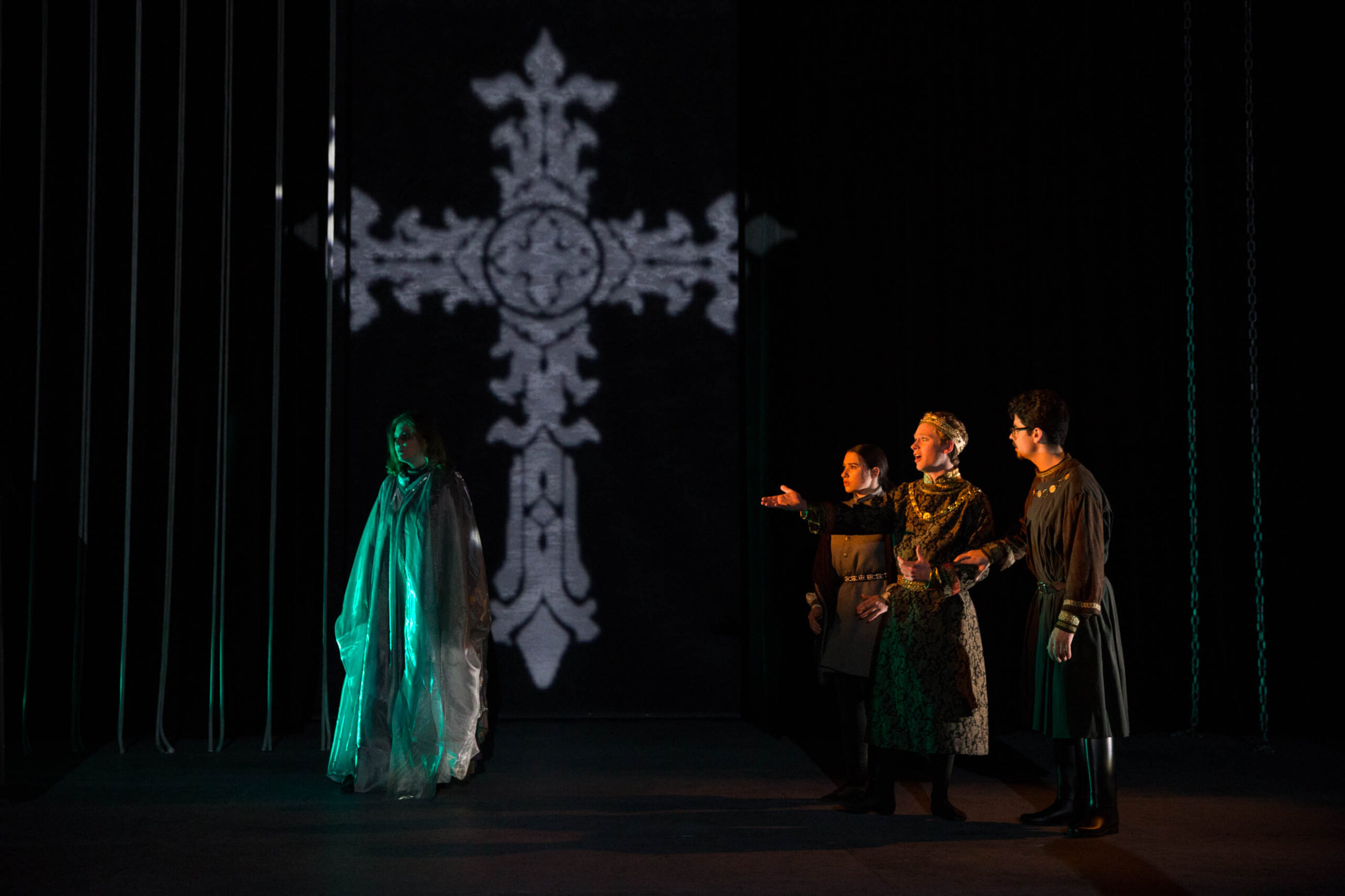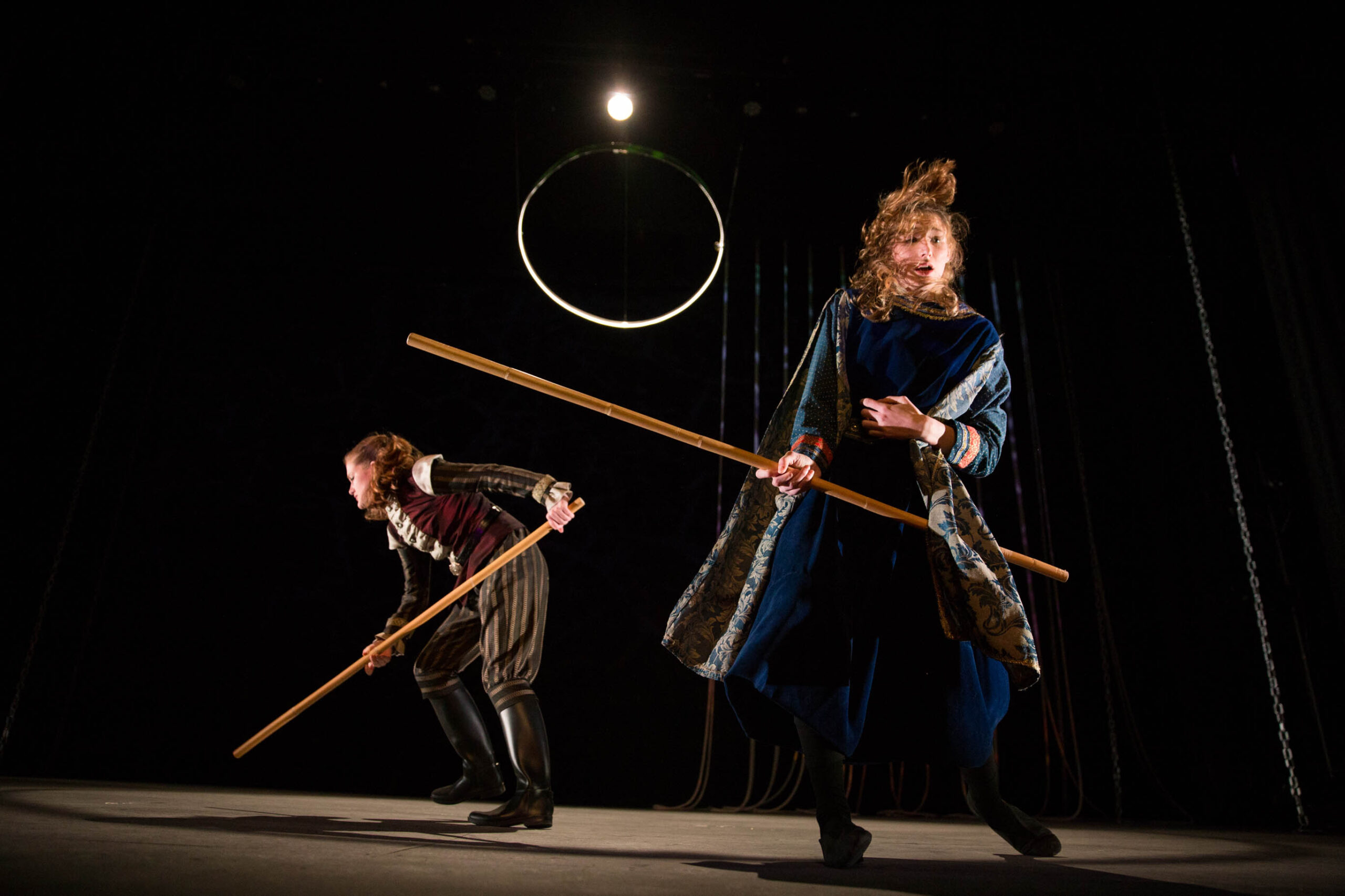‘Henry VI, Part II’ cast prepares to take the stage
February 28, 2020
 Ann Basu
Ann BasuA throne perches atop an eight-foot high platform, an illuminated golden hoop descends from the ceiling and thick lengths of rope frame the stage. This sleek depiction of a castle interior sets the scene for an often-overlooked Shakespearean war drama.
The theater department’s spring play, “Henry VI, Part II,” offers a side of Shakespeare that many audience members may have never experienced before. With its suspenseful sound scape, glimmering projections and minimalist set design, the show affords a fresh look to the historical events of over 500 years ago.
Sally Wood, visiting assistant professor of theater and director of the play, chose “Henry VI” after seeing it performed in London, an experience that changed the way she thought about Shakespearean theater.
“[After it ended] I took a breath, and I was like, ‘Oh my God, I didn’t know theatre could be like that,’” Wood said.
The play is the second installment of a trilogy that centers around the life of historical figure King Henry VI of England. In “Part II,” Henry VI struggles to control quarrelling between members of British nobility and prevent an impending war.
Penny Mack ’22 plays York, a member of the English nobility who believes that he is true heir to the throne. Mack said she was initially uncertain about how to portray a character who was based on a historical figure.
“I think the challenge was finding complexity in characters that wasn’t immediately evident from what seemed like just a cut and dry historical piece,” Mack said.
Casting happened before winter break, but the actors did not start blocking the scenes until after they returned. Tori Clarke ’20, who is stage manager for the play and a theater major, says that the production’s short timeline meant that actors had less time to interpret the language.
“I think that’s part of what’s been so hard about doing this show so quickly is the intricacies of Shakespeare’s language,” she said. “I’m taking advanced acting this semester, and we spent four weeks on one Shakespeare soliloquy, whereas they’re spending six weeks on an entire play.”
Wood worked closely with the actors to help them become comfortable with the language, asking the actors to translate all of their lines into modern English and count the number of syllables in each line.
Charlotte Gifford ’23, who plays Somerset, said that translating her lines helped her to understand the motivations of her character.
“You can really get acquainted with their prose in a way that I think you normally wouldn’t if you were just learning lines that can be spoken normally,” she said.
In addition to adjusting to the language, performers had to prepare for stage combat scenes. Wood, whose specialty is directing Shakespearean stage combat, said that these scenes are usually the most rehearsed parts of any performance.
 Ann Basu
Ann BasuClarke said that a play with both Shakespearean language and stage combat demands a particular kind of commitment from the performers.
“Because it is Shakespeare and because there’s so much combat, when they get here every night their mind has to be here, and it has to be present,” Clarke said. “I think that the fact that the show requires that is actually part of what makes it so strong.”
The play, which lasts approximately 90 minutes, is significantly shorter than its original version. Wood cut down the play and removed lengthy monologues during which actors recount previous plot events.
“It’s hard because it’s beautiful language, and I hate to cut it,” she said. “But it’s also really important to have a manageable amount that the students can learn, that the tech can support.” she said.
This stripped-down approach is also apparent in the set, which relies on simple cues to convey setting changes to the audience. For instance, changes in the formation of the hanging rope curtains around the stage reflect the shape of palace walls and, later, of a ship.
Ben Allen ’23, who plays King Henry VI, said that the set design surprised him.
“When I did ‘The Tempest,’ like way back in high school, we had this big ol’ set, and there were different layers; it was a lot,” Allen said. “This show, it’s very much minimalistic.”
Wood said that she’s excited to produce a Shakespeare play that many audience members have likely never seen before.
“I’m telling everybody that I know,” she said. “I’m like, ‘When’s the last time you saw Henry VI, Part II?”
The show will be performed tonight and Saturday at 7:30 p.m. and Sunday at 2 p.m. in Pickard Theater. Tickets can be reserved online.
Comments
Before submitting a comment, please review our comment policy. Some key points from the policy:
- No hate speech, profanity, disrespectful or threatening comments.
- No personal attacks on reporters.
- Comments must be under 200 words.
- You are strongly encouraged to use a real name or identifier ("Class of '92").
- Any comments made with an email address that does not belong to you will get removed.

Phenomenal performance! Many congratulations to all concerned.